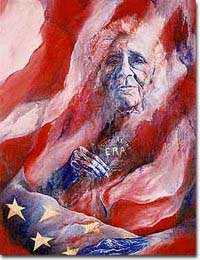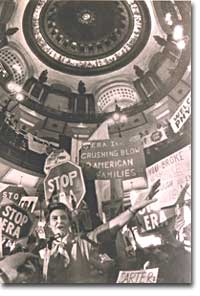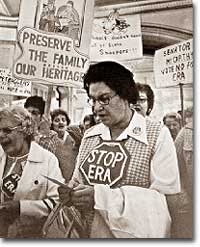57c. The Equal Rights Amendment

As founder of the National Women's Party, Alice Paul first introduced the Equal Rights Amendment to Congress in 1923. Paul would work for the passage of the ERA until her death in 1977.
"Equality of rights under the law shall not be abridged by the United States or by any State on account of sex."
This simple sentence comprised Section 1 of the Equal Rights Amendment (ERA), which was first proposed in Congress by the National Women's Party in 1923. Feminists of the late 1960s and early 1970s saw ratification of the amendment as the only clear-cut way to eliminate all legal gender-based discrimination in the United States.
Amending the Constitution is a two-step process. First, the Congress must propose the amendment by a two-thirds majority in both the House and Senate. After proposal, it must be ratified by three-fourths of the state legislatures. Organizations like the National Organization of Women (NOW) began a hard push for the ERA in 1970.

Phyllis Schlafly was perhaps the most visible opponent of the Equal Rights Amendment. Her "Stop ERA" campaign hinged on the belief that the ERA would eliminate laws designed to protect women and led to the eventual defeat of the amendment.
Leaders such as Gloria Steinem addressed the legislature and provided argument after argument in support of the ERA. The House approved the measure in 1970, and the Senate did likewise in 1972. The fight was then taken to the states. ERA-supporters had the early momentum. Public opinion polls showed strong favorable support. Thirty of the necessary thirty-eight states ratified the amendment by 1973.
But then the tide turned. From nowhere came a highly organized, determined opposition that suggested that ratification of the ERA would lead to the complete unraveling of traditional American society.
The leader of the Stop-ERA campaign was a career woman named Phyllis Schlafly. Despite her law degree, Schlafly glorified the traditional roles of American women. She heckled feminists by opening her speaking engagements with quips like "I'd like to thank my husband for letting me be here tonight." Schlafly argued that the ERA would bring many undesirable changes to American women.

The fight over the Equal Rights Amendment did not pit women against men — it pitted two ideologies against eachother.
Protective laws like sexual assault and alimony would be swept away. The tendency for the mother to receive child custody in a divorce case would be eliminated. The all-male military draft would become immediately unconstitutional. Those opposed to the ERA even suggested that single-sex restrooms would be banished by future courts.
Stop-ERA advocates baked apple pies for the Illinois legislature while they debated the amendment. They hung "Don't draft me" signs on baby girls. The strategy worked. After 1973, the number of ratifying states slowed to a trickle. By 1982, the year of expiration, only 35 states had voted in favor of the ERA — three states shy of the necessary total.
Feminist groups maintained that a serious blow was struck toward the idea of gender equity in the United States. They also saw women divided against other women. Despite early gains by the feminist movement, the rise in social conservatism led Americans of both genders to draw limits on a constitutionally mandated equality between the sexes.






